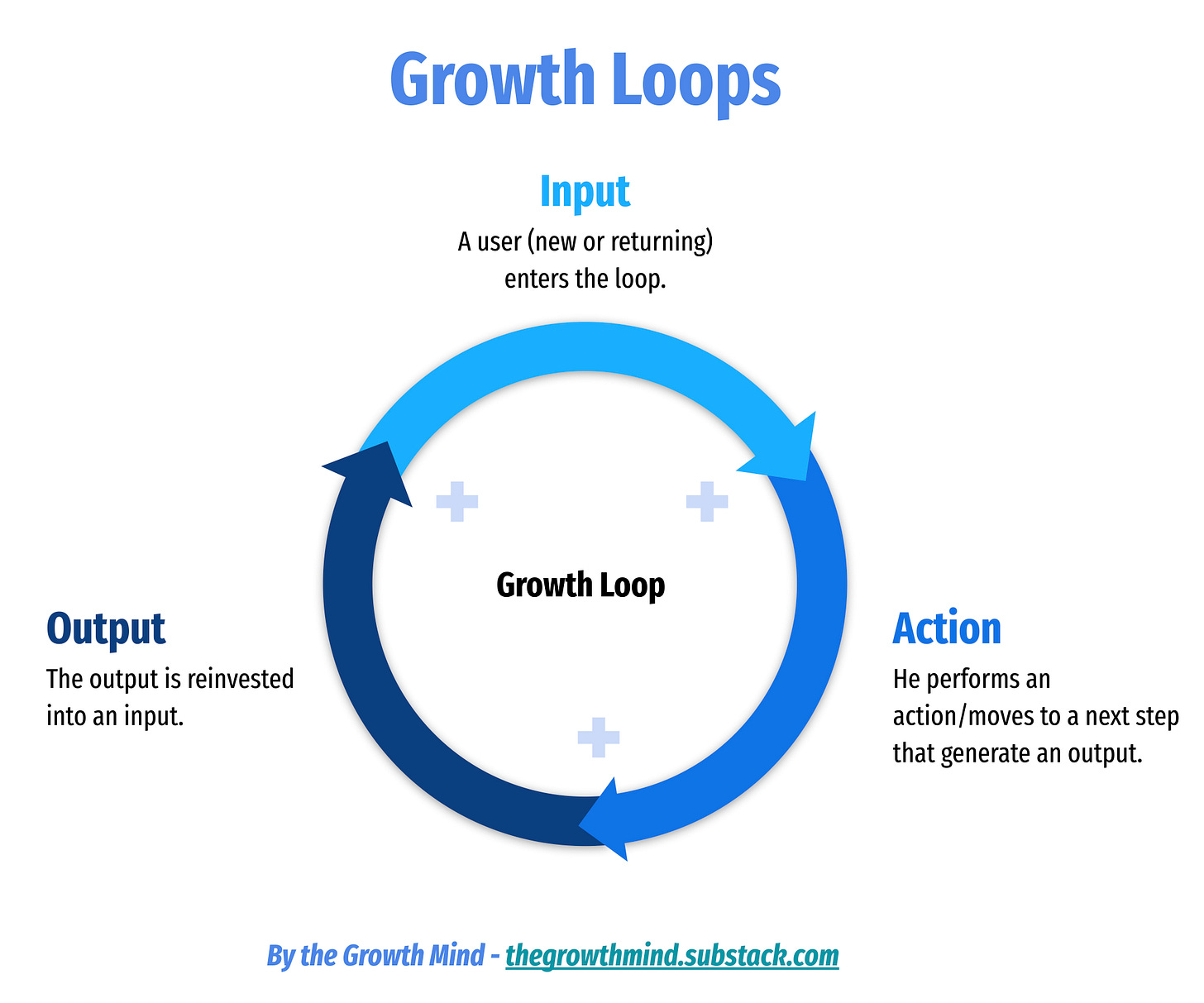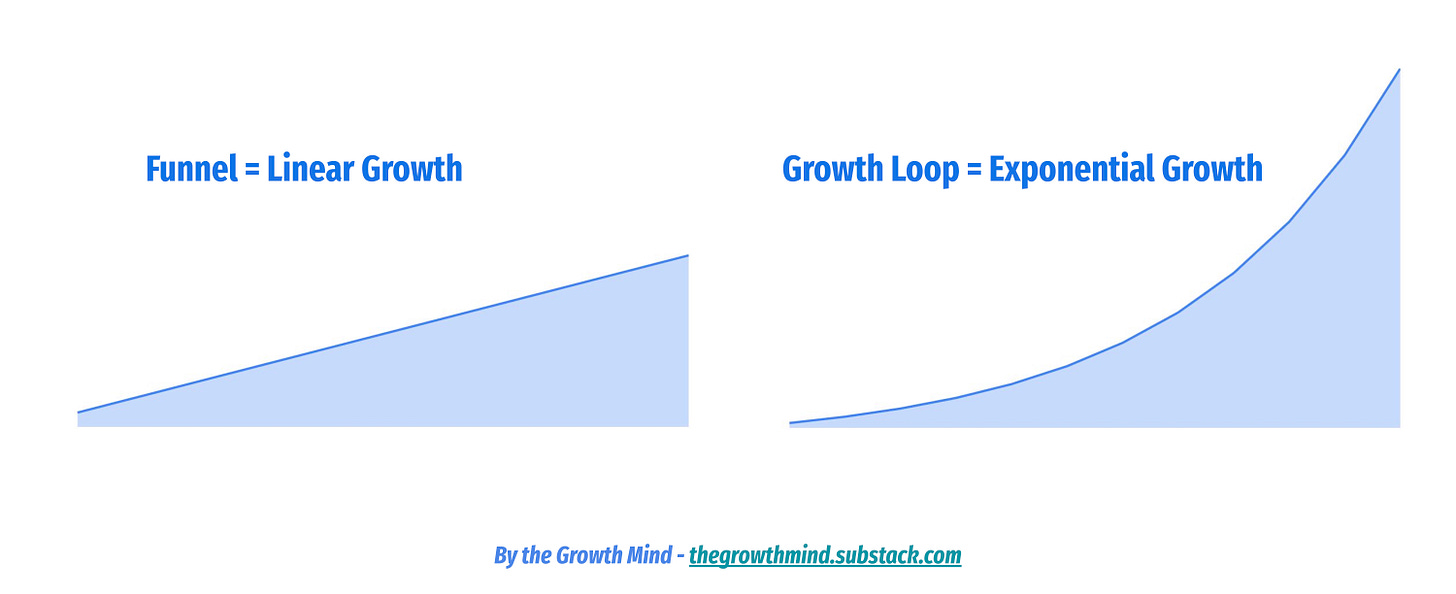Growth Loops : the path to exponential Growth ? 📈
Achieve compounded growth effects by implementing Growth Loops.
Hello, it's Pierre-Jean from The Growth Mind 👋
Today we're going to talk about an exciting topic: Growth Loops 🔄
For several years, funnels have been used in growth. Especially the AARRR funnel (Acquisition - Activation - Retention - Referral - Revenue), which has become a true emblem of the discipline. And which remains a basis for understanding the different stages of the user journey.
But for some time now, the limits of the funnel have been felt: too linear, it creates silos between teams and does not deliver compounded growth effects. That's where Growth Loops come in.
They allow you to visualize growth in the form of loops that feed and grow continuously. A formidable vision to adopt for exponential growth that benefits from compounded effects.
In this edition of The Growth Mind, you’ll learn:
What is a Growth Loop 🔄
AARRR funnel vs Growth Loops: which model to apply? 🥊
The 4 categories of Growth Loops 📝
Strava, Lydia & Vinted: 3 examples of Growth Loops to inspire you 💡
Growth Loops: adopting a circular vision of Growth to take advantage of compounded effects.
Growth Loops is a concept introduced by Reforge, a global community of experts in Growth, Product Management and Tech, led by Brian Balfour, former VP Growth at Hubspot and now CEO of Reforge.
The concept of Growth Loops, adopted and popularized by the best tech companies, is simply understandable and formidable powerful: they allow you to visualize growth in the form of a loop in which each Input, through an action or by passing a step, produces an Output.
The output generated at the end of the loop can then be reinvested as an input and make the loop bigger, benefiting from compounded growth effects.
These compounded effects allow the Growth Loop to grow exponentially and not linearly: the secret of the most successful tech companies.
Growth Loops must answer 3 fundamental questions:
What : What action triggers the loop? This action must reflect the reception, creation, or distribution of value.
Who : Who performs the action at the heart of the Growth Loop? In most cases, the person performing the action is a user/customer. But in some types of Growth Loops, it could also be a supplier, a partner, or even someone internal to the company who triggers the action.
Why : What is the deep motivation (financial, social, personal...) that drives a person to perform the action at the heart of the Growth Loop? This question is crucial to understanding how to maximize the action within your Growth Loop.
Using Growth Loops to maximize growth allows you to:
Visualize different stages of the customer journey, such as acquisition, activation, and referral, within the same loop. In a Growth Loop, each metric is interconnected: the growth of one directly contributes to the growth of the other.
Break down silos between teams: the components of a Growth Loop can involve the participation of marketing, product, tech, or customer success, who must work together to ensure an effective Growth Loop.
Invest and experiment holistically: instead of focusing on a specific metric (such as acquisition), we seek to improve the efficiency of the loop as a whole so that its impact is reflected on multiple metrics.
Funnel AARRR vs Growth Loops: which model to apply?
The AARRR funnel, introduced by Dave McClure, has had a significant impact on how startups model their growth.
But the funnel vision is now seriously called into question, rightfully so.
Although I am personally a big fan of the funnel vision and what the AARRR framework has brought to Growth, we can clearly see some limits: a funnel needs to be continuously fed to generate growth.
There are two ways to optimize the final output of a funnel:
Feed the top of the funnel more substantially: generate more leads by increasing volumes and/or acquisition budget.
Improve the conversion of each stage of the funnel: work on moving from one stage to the next.
These two tactics will ultimately optimize revenue, but do not create a virtuous growth cycle. The funnel must be continuously fed for growth to follow. If it is not optimized or abundantly fed, the company is exposed to linear growth.
Growth that becomes fragile when an acquisition channel reaches saturation or when conversion rates drop.
Unlike the AARRR funnel, Growth Loops maximize the impact created by each user integrating into the loop.
The investment made at the input of the loop produces a result that will in turn feed the loop again (the output). Theoretically, once a user has entered a Growth Loop, and if the output is greater than the input, the loop can feed itself organically and grow exponentially without the need to continue feeding it.
In practice, feeding it continuously remains essential to maximize its impact and velocity to ensure an exponential effect on growth.
The main advantage of a Growth Loop compared to a Funnel? The compounded effects, which surpass the linear vision of the funnel.
Many Growth experts now advocate for the continued use of the AARRR framework, but in the form of a loop rather than a funnel. In my opinion, they are totally right: the essence of this framework is to allow visualization of the steps a user/customer goes through. However, this does not imply that it is necessarily chronological and linear. The adaptation into a funnel is simply a way to visualize it rather than a real rigid structure.
The 4 categories of Growth Loops
Acquisition loops 📊
The acquisition loops are probably the most commonly used Growth Loops.
There are two main types of acquisition growth loops:
Paid acquisition loop
Each user acquired through a paid channel brings revenue to the company. If the revenue generated by acquiring a user over their lifetime is higher than the acquisition cost (positive LTV/CAC ratio), this revenue can be reinvested in paid acquisition. By maximizing the Payback Period (the time required to recoup the investment made to acquire a user), you can increase the speed at which the Growth Loop cycle completes and gain velocity on your growth.
Organic acquisition loop
Each user acquired allows for the acquisition of one or more additional users. This type of loop is particularly powerful because the acquisition cost for a user is ultimately spread out over multiple users.
Referral loops 🗣️
Viral loops are very effective in organically growing a product.
To create a referral loop, sharing links, referral programs, or financial incentives are good ways to maximize referrals.
Even better, having a product that users benefit from fully when they recommend it is the best way to create a viral loop (as Lydia does, which we will discuss shortly).
A good example of a referral loop is the Facebook invitations during the mobile game era: to progress in the game, you had the option of inviting your friends to play the game, which allowed you to earn lives or points. Although this tactic is somewhat outdated, it is a very interesting use case for viral marketing.
Content loops 📺
With the rise of content-led growth (growth organized around content creation), it is likely that we will see more and more Content loops.
A Content loop is structured as follows:
Input: new user.
Action: the user produces content on the platform, which improves its SEO.
Output: new users discover this content and sign up for the platform.
This is the type of loop used by Pinterest or Quora, for example. Users post content on the platform. It is indexed on Google and helps attract new users.
Product experience loops 🧠
A type of Growth loop that is totally different from the previous ones is a Product experience loop, which implies that each registered user improves the overall product experience.
The more users a product has, the better the experience for everyone. The core quality of the product increases thanks to the acquisition of new users. And acquisition improves because the product gets better.
We are talking here about Macro Loops: two interconnected loops that feed each other and each contribute to the improvement of the other.
Strava, Lydia & Vinted : 3 examples of Growth Loops
Strava - An acquisition loop based on performances sharing
The Growth Loop of Strava is based on the pride (Why) that users (Who) have in sharing their performance (What) on social networks.
Strava allows, with just a few clicks, to share a summary of a sports activity in an Instagram, Facebook, or Snapchat story. An excellent way to capitalize on its community to promote its app.
Lydia - A viral acquisition loop
Lydia is a French neobank, really similar to Revolut, which is used by a vast majority of French people between 18-35 years old living in urban areas.
The example of Lydia shows us how an app can quickly establish itself in the habits of its users. When someone wants to repay another person, they will suggest doing a "Lydia" to them. If the user is not registered on Lydia, they will install the application to receive their repayment quickly. This phenomenon has generated the expression "I'm doing a Lydia for you?", which is a perfect example of a Referral loop.
Vinted - A marketplace growth loop, maximizing supply and demand
Vinted's Growth Loop is specific to the marketplace model, where a good fit must be found between Supply and Demand. This Growth Loop also applies to other marketplaces like Airbnb or BlaBlaCar.
By increasing the supply (the number of sellers who list items for sale), Vinted improves the experience for buyers (demand). This demand therefore increases mechanically. The more demand increases, the more sellers are encouraged to develop their activity. The overall quality of the experience, for both sellers and buyers, improves over time.
The challenge is to find a balance between the two sides of the marketplace, Supply and Demand.
We will also address the topic of the marketplace model in a future edition: stay tuned!
Growth Loops are an essential concept to achieve exponential growth. Each input maximizing output, they allow you to capitalize on compounded growth effects. Unlike funnels whose vision is linear.
That's all for today. See you in two weeks for the next edition of The Growth Mind! 👋








Ultra quali comme d'hab. Ce que tu proposes c'est de pas considérer le "funnel AARRR" comme un funnel, mais plutôt comme un "framework AARRR" pour dépasser le plafond de verre qu'impose un funnel global.
L'idée : avec un framework, libre à toi de créer un funnel d'acquisition ou une growth loop d'acquisition si j'ai bien compris :)
Super intéressant ! Aurais tu des exemples sur de l’acquisition en B2B ? Merci !